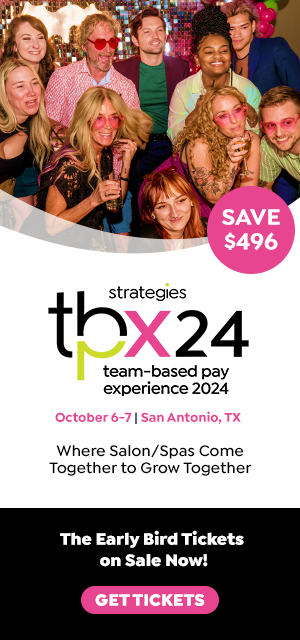The No-Compromise Approach to Building and Protecting Your Salon or Spa
 Every company has a vision of what it will become. That vision defines how big a company will grow, the markets it will serve, its commitment to excellence, its core values, its growth opportunities, its potential financial rewards and all those other lofty and worthy things that represent a well-crafted vision. Company visions are supposed to be enticing and empowering because they define the quest. But within those visions resides one of the most essential components to achieving any goal - your "brand."
Every company has a vision of what it will become. That vision defines how big a company will grow, the markets it will serve, its commitment to excellence, its core values, its growth opportunities, its potential financial rewards and all those other lofty and worthy things that represent a well-crafted vision. Company visions are supposed to be enticing and empowering because they define the quest. But within those visions resides one of the most essential components to achieving any goal - your "brand."Envision a large funnel with an incredibly tiny opening at the bottom. You pour all those precious elements of your vision into the top of the funnel and stir it up a bit. What emerges from that tiny opening is a little encapsulated entity that represents the uniqueness, qualities, abilities, reputation and purpose of your company. It is simply called your brand. If you mix in all the right vision elements, your brand will be extremely valuable and precious. But what many leaders fail to realize is that their company brand is also extremely delicate and susceptible to damage from just about everything. Just as leaders are responsible for protecting a company's culture, so too are they responsible for protecting the company's brand.
Here are my No-Compromise strategies to building and protecting your brand:
- It's about protecting the promise: The essence of a brand is its consistency and dependability in delivering on its promise to the customer. If you promise quality, deliver it. If you promise being on time, be on time. If you promise a unique experience, provide it. The best brands are brands consumers and buyers can trust. It's that "meeting and exceeding expectations" thing in real time. What's your promise to the customer? Where and how often is that promise compromised?
- Take the test: Stop reading and, out loud, describe your company's brand. Did you get cool chills from its awesomeness? If not, you've got a lot of work to do. Again, I'm not talking about a vision statement here. I'm talking about your brand - the product, service, and experience you consistently and relentlessly deliver … and your company's reputation. When you start to get those cool chills from the "describe your brand out loud" test, challenge the members of your leadership team to take the test as well. Then try it out on the people that are closest to your customers - your employees. If there isn't at least some semblance of consistency in their responses, you've got work to do on defining your brand.
- It's unique and proprietary: If your brand description sounds a lot like your competition's, you've got a brand identity problem. The best brands "own" a segment of the market. Why? Because if a consumer wants it, there's only one place to get it - your company. Everything else is a knockoff and a compromise. The more unique and proprietary your brand, the less price matters. That's why Apple can sell iPhones, iPads and Mac computers at premium prices that flat out kill the competition. That's why my wife and I just bought a Tempur-Pedic mattress. We wanted the real deal and we were willing to pay for it. The more you "own" the process, technology, product and experience, the more unique, influential and valuable your brand becomes … and the more your competition is forced to compete on price.
- Excellence is more than a choice: Target and Walmart may be value-based brands, but they do offer their version of "value-excellence." Comparatively, Nordstrom is at the premium price level and offers its own version of "premium-excellence." The key is that whatever your version of excellence is, it must be embedded in your brand and its identity. The more premium your price point, the higher the concentration of excellence in your brand should be. Tesla is the maker of "premium electric vehicles." Everything about the Tesla brand speaks "excellence" to support their premium brand. Just visit one of their Tesla stores and you'll experience branding at its very best. And by the way, Tesla not only builds truly amazing electric cars - they own the technology.
- The bond of culture and brand: Logos, products and marketing support a brand, but it is the people that bring a brand to life. And the moment the human factor enters the brand conversation, so does the collective thinking and behavior of the company - better known as the company’s culture. To drive this point home, I always suggest replacing the term "culture" with "attitude." What is your company's collective attitude? When a customer enters your business, calls on the phone, or interacts one-on-one in any way with your company, what attitude do they experience? Simply put, great brands can and will be compromised if the collective thinking and behavior of your company - its culture - is not in sync with your intended brand.
- The no-compromise brand: Leaders are the keepers and protectors of a company's culture and its brand. It's tough and relentless work to keep culture and brand components dialed in to the realities of economic trends and competitive threats. But the biggest threat to a brand resides within the company itself and begins with its leadership. No-compromise leadership is about creating dynamic cultures capable of supporting dynamic brands. Like excellence, growth and profitability, the no-compromise brand is an outcome.
- - - - - - - - -
Please share your thoughts with me about today's Monday Morning Wake-Up. Click above to comment.
Pass this e-mail on to your business colleagues, managers and friends. They’ll appreciate it.


Comments
No comments found. Start the conversation!
Leave a Comment